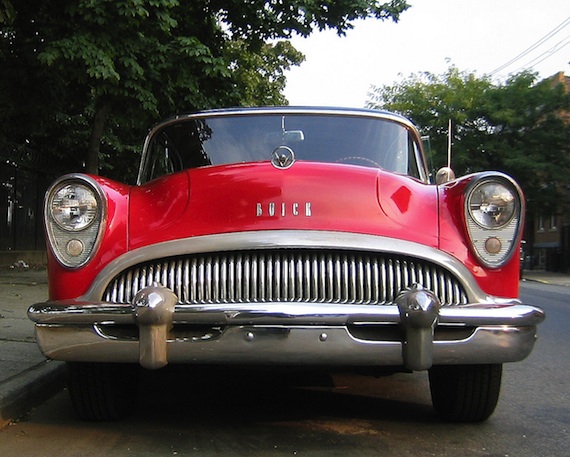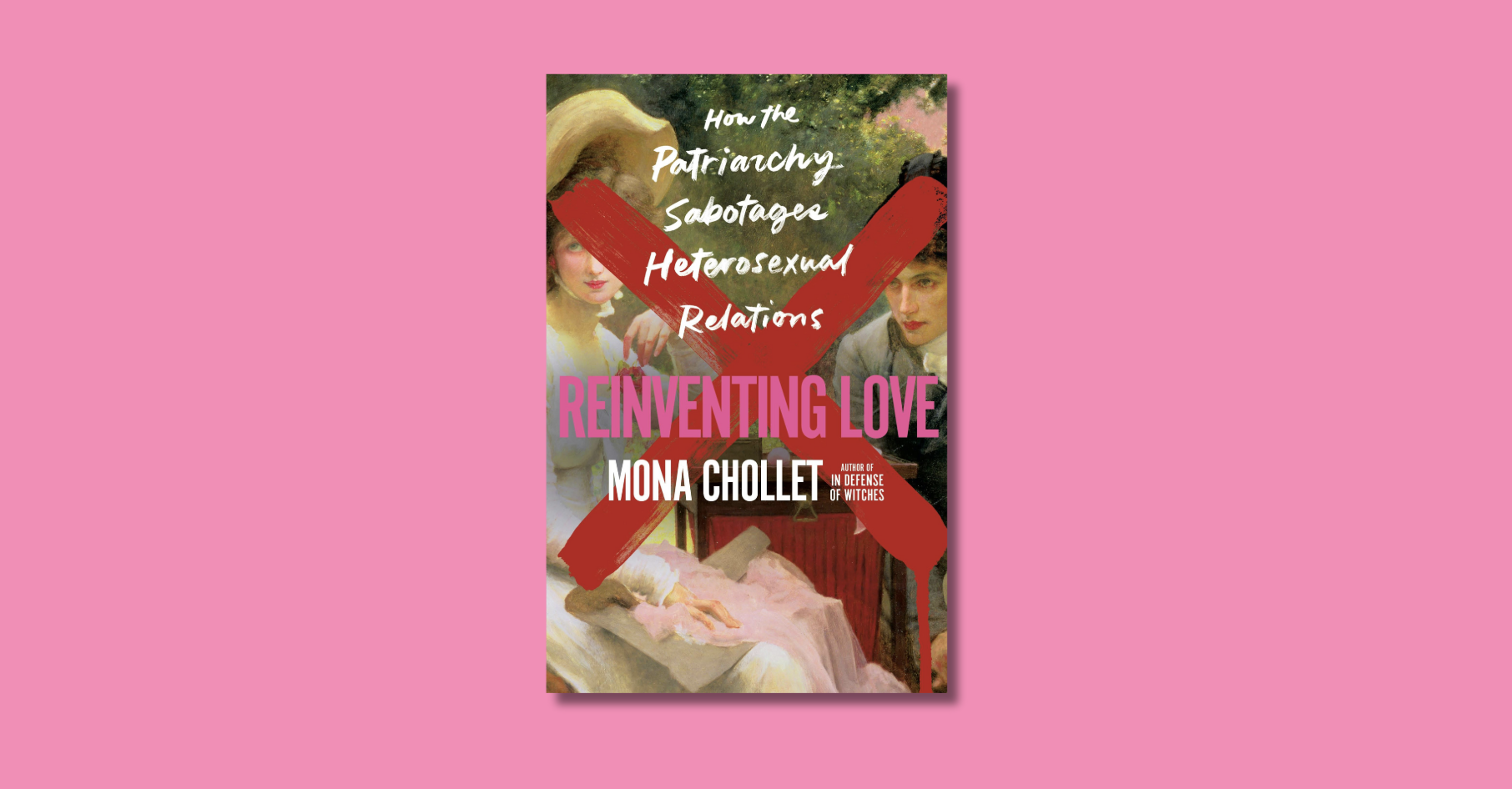
Behold the magisterial front end of the 1954 Buick: the toothy chrome grill, the sharply tipped mammiferous bulbs of the “Dagmar” bumper, the “bombsight” hood ornament, the tear-drop headlights, all of it wrapped in luscious lipstick-red sheet metal. This rolling work of art serves as proof, if any were still needed, that they don’t make cars like they used to. It has also served as the muse for all the fiction I have written, providing a way for me to travel, in comfort and at speed, into my chosen theme: the hollow promises of the American Dream in the years following the Second World War.
Many people under the age of 40 have trouble believing it, but there was a 30-year period, from roughly the mid-1940’s until the mid-1970’s, when the United States of America truly had it going on. The economy was robust, the middle class was thriving, cars were big and fast and flashy and fun, and infectious pop music kept pouring out of Muscle Shoals, Memphis, Motown, and countless points in between.
It didn’t last, of course. It couldn’t possibly last. The buzz kill ’70s brought Arab oil embargoes, military defeat in Vietnam, the trauma of Watergate, and the simultaneous decline of Detroit and rise of the Japanese auto industry. And then, to seal the deal, along came disco, followed by Ronald Reagan and the long, systematic dismantling of the American middle class.
Those of us who lived through the so-called golden years of the so-called American Century tend to edit out certain inconvenient subtexts. There was the ever-present dread of nuclear annihilation; and if you happened to be a person of color, female, poor, or gay, there was (and still is) a good chance you were not enjoying a full share of the bounty. America’s swagger, it turns out, was built on flimsy hubris, a blinkered parochialism, and major inequalities. Oh, and cheap oil.
Yet there is no denying that something magical happened in America in the three decades after the Second World War, and it’s not surprising that writers continue to mine those years not only for their exuberant hardware, but also as a measure of just how much the world has changed. Almost always, that’s a way of saying just how much we’ve lost.
Timothy Walsh is the latest writer to revisit those expansive, metaphor-rich boom years. His third book of poetry is called When the World Was Rear-Wheel Drive, an automotive metaphor that establishes Walsh’s attachment to a time before today’s de-sexed, front-wheel drive, fuel-efficient hybrid cars, which is to say a time before our globalized economy and its computers and ruthless efficiency and digitized everything. The book’s subtitle is New Jersey Poems, and while there is a strong sense of place — the Jersey suburbs and shore, the looming allure of nearby New York City, that “oversize Oz” — the subtitle could also have been Rust Belt Poems, for these poems will resonate with anyone who lived in America’s industrial cities at their peaks, places like Newark and Buffalo and Cleveland and Detroit, places that suffered horrifically when America shed its rear-wheel drive past and American industry moved overseas, taking a way of life with it.
 Walsh — a white, Catholic, middle-class baby boomer — beautifully captures what it was like to come of age in that vanished world. It was a world of ice cream trucks, Halloween pranks, jobs delivering newspapers, and pumping gas, eventually moving on to the adolescent world of girls and garage bands, motorcycles and muscle cars. This sounds more Mayberry than it reads on the page. Walsh deftly renders a world on the cusp — it’s both palpable and in the process of vanishing. He captures what Elizabeth Spencer captured in her 1960 novella The Light in the Piazza — “America’s midcentury moment of confidence,” in the words of Michael Gorra, “the confidence of people who thought, however briefly, that they could do anything.” A sense of the imminent, inevitable loss of this confidence is at the core of these poems, and it comes through most viscerally when people are in cars. Here’s a memory of riding in a Buick Wildcat:
Walsh — a white, Catholic, middle-class baby boomer — beautifully captures what it was like to come of age in that vanished world. It was a world of ice cream trucks, Halloween pranks, jobs delivering newspapers, and pumping gas, eventually moving on to the adolescent world of girls and garage bands, motorcycles and muscle cars. This sounds more Mayberry than it reads on the page. Walsh deftly renders a world on the cusp — it’s both palpable and in the process of vanishing. He captures what Elizabeth Spencer captured in her 1960 novella The Light in the Piazza — “America’s midcentury moment of confidence,” in the words of Michael Gorra, “the confidence of people who thought, however briefly, that they could do anything.” A sense of the imminent, inevitable loss of this confidence is at the core of these poems, and it comes through most viscerally when people are in cars. Here’s a memory of riding in a Buick Wildcat:
What I remember most were those butterfly windows,
those hinged triangles of glass that angle outward
so you could ride with the windows wide open
and not get blasted by road wind.Butterfly windows – gone the way of telephone booths,
transistor radios, and fountain pens.
Now we drive, hermetically sealed in sleek,
air-conditioned cars,
engines silent as stealth,
traveling through the world like something preserved
in glass jars,
shutting out the sounds and smells of summer –
the drone of cicadas and lawnmowers,
the musk of new-mown grass.
I also hear echoes of Philip Levine, the great poet of my hometown, Detroit, who captured the drudgery, terror, and occasional beauty of factory work in such books as Not This Pig and What Work Is. Here is Walsh’s description of working at a gas station:
When the big tanker trucks rumbled in,
dropped their load of gas into the underground tanks,
someone had to climb up with a flashlight
to check that the truck was actually empty.
Peering into the truck’s gaping belly, gasoline vapors
swirling, a voluptuous fog,
the polished steel innards gleaming like a gun-metal dawn,
it never didn’t occur to you that one spark –
one errant static discharge –
and you were history – blown to smithereens,
your molecules and atoms salting the woods,
raining down on the river.
There is humor here, too, including a poem called “Slingshot in the Confessional,” which goes a long way toward explaining why Catholics tend to be among the most imaginative and inveterate sinners:
Kneeling in the dark confessional, speaking through the screen,
the dark shadow-shape of the priest lurking,
you’d recite your litany of minor disobediences, curse words,
lies, and fights,
the squirt gun or slingshot in your pocket
equally contrite.In the name of the Father, the Son, and the Holy Ghost,
the priest would conclude,
sending you forth into the world cleansed and refreshed,
ready to embark on another round of transgressions.
 In his memoir called Downtown, Pete Hamill gives voice to a nostalgia much like Walsh’s, but filtered through the eyes of immigrants, including his Irish-born parents. Hamill defines this nostalgia as “an almost fatalistic acceptance of the permanence of loss.” Hamill’s parents lost the world of the Old Country; Walsh and his post-war New Jersey clan lost an equally vibrant world. Hamill writes:
In his memoir called Downtown, Pete Hamill gives voice to a nostalgia much like Walsh’s, but filtered through the eyes of immigrants, including his Irish-born parents. Hamill defines this nostalgia as “an almost fatalistic acceptance of the permanence of loss.” Hamill’s parents lost the world of the Old Country; Walsh and his post-war New Jersey clan lost an equally vibrant world. Hamill writes:
Every immigrant knew what Africans had learned in the age of
slavery: that there was a world that was once there in the most
intimate way and was now gone. Part of the past. Beyond retrieval.
On the deepest level, it didn’t matter whether you had that past taken
from you, as had happened to the Africans, of whether you had
decided personally to leave it behind. At a certain hour of the night,
the vanished past could be vividly alive.
When the World Was Rear-Wheel Drive is that certain hour of the night. It understands that loss is imminent and inevitable, and that the things we have lost are beyond retrieval. That’s what makes it so painful, and so lovely.








